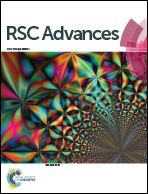Hyaluronic acid–PEI–cyclodextrin polyplexes: implications for in vitro and in vivo transfection efficiency and toxicity
Abstract
The present study reveals novel HA–PEI–CyD polyplexes as non-viral vectors for gene delivery. The conjugate was synthesized and the phenol–sulfuric acid method revealed ∼5% and 14% grafting of cyclodextrin and hyaluronic acid, respectively, in the final conjugate. Model plasmid DNA, pEGFP-N3, was complexed with synthesized HA–PEI–CyD and a N/P ratio of 10 was found to be optimal and exhibited excellent stability in presence of serum and DNase I. In vitro transfection of HA–PEI–CyD polyplexes in HeLa, HEK-293 and MCF-7 cells revealed ∼39.5, 41.4 and 8.8 fold higher transfection as compared to plain PEI, respectively. Confocal laser scanning microscopy confirmed the higher cellular uptake and efficient nuclear colocalization of the HA–PEI–CyD polyplexes. An MTT assay revealed >90% cell viability in HA–PEI–CyD polyplexes in contrast to ∼20% cell viability in plain PEI. Furthermore, excellent GFP expression in tumor bearing animals and significantly lower in vivo toxicity along with hemocompatibility demonstrated the suitability of the proposed conjugate for gene delivery.


 Please wait while we load your content...
Please wait while we load your content...